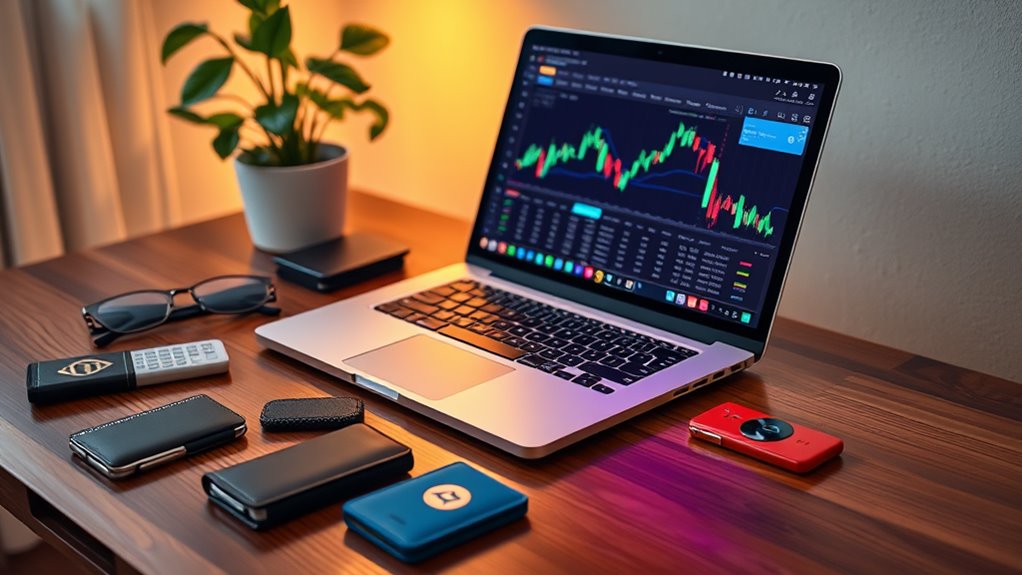
Decentralized Exchanges: What Are DEXS and How Do They Work?
Decentralized exchanges (DEXs) are cryptocurrency trading platforms that operate without intermediaries, using blockchain technology and smart contracts. Unlike centralized exchanges, DEXs allow users to maintain control of their private keys and funds, reducing hack risks and eliminating the need for third-party approval. They function through either order book systems or automated market makers (AMMs) that use liquidity pools for trading. DEXs form a cornerstone of the DeFi movement, providing permissionless access to financial services worldwide.
Key Takeaways
- DEXs are peer-to-peer cryptocurrency trading platforms that operate without intermediaries using blockchain technology and smart contracts.
- Unlike centralized exchanges, DEXs maintain user custody of funds, reducing hacking risks and eliminating approval requirements.
- DEXs use two main trading mechanisms: order books that match buyers and sellers, and automated market makers utilizing liquidity pools.
- Security is maintained through non-custodial wallets, where users control their private keys rather than surrendering funds to third parties.
- DEXs operate 24/7 as foundational DeFi infrastructure, enabling global financial access without geographic restrictions or identity verification requirements.
Decentralized Exchanges: What Are DEXS and How Do They Work?

Decentralized Exchanges: What Are DEXS and How Do They Work?
Numerous cryptocurrency enthusiasts are turning to decentralized exchanges (DEXs) as an alternative to traditional trading platforms. These peer-to-peer marketplaces operate without intermediaries, using blockchain technology and smart contracts to facilitate direct trading between users.
DEXs are distinguished by their non-custodial nature, meaning users maintain control of their funds throughout transactions. Unlike centralized exchanges, DEXs never take possession of user assets, reducing the risk of hacks. Common types include order book DEXs, automated market makers (AMMs), and DEX aggregators.
To use a DEX, traders connect their crypto wallets, select tokens to swap, and confirm transactions. While DEXs offer enhanced privacy and access to a wider range of tokens, they typically require users to pay network fees and may face liquidity limitations. Additionally, many DEXs leverage liquidity pools to provide continuous trading opportunities without relying on traditional order books.
The Evolution of Cryptocurrency Trading Platforms

Since the creation of Bitcoin in 2009, cryptocurrency trading platforms have undergone a remarkable transformation, evolving from rudimentary exchange mechanisms to sophisticated financial ecosystems.
BitcoinMarket.com emerged as the first trading venue, followed by Mt. Gox, which dominated the market until its collapse highlighted critical security vulnerabilities.
Early exchanges like BitcoinMarket.com and Mt. Gox revealed the industry’s growing pains, exposing fundamental security challenges that would shape future platforms.
The landscape subsequently diversified with centralized exchanges like Coinbase (2012) and Binance (2017) prioritizing user experience, security, and regulatory compliance.
These platforms facilitated mainstream and institutional adoption by supporting multiple cryptocurrencies and implementing rigorous security protocols.
More recently, decentralized exchanges (DEXs) have gained prominence within the DeFi movement. Platforms like Uniswap utilize blockchain technology and smart contracts to enable peer-to-peer trading without intermediaries, offering enhanced privacy and security compared to their centralized counterparts. Decentralized finance aims to democratize access to financial services, increasing their availability and efficiency worldwide.
Core Principles Behind Decentralized Exchanges

Decentralized exchanges operate on a permissionless architecture that allows any user to participate in trading without requiring approval from central authorities.
This fundamental design principle eliminates gatekeepers and creates an open financial system where users from any location can access markets regardless of their background or status.
The self-custody value proposition further enhances user autonomy by enabling traders to maintain complete control of their assets throughout the transaction process, greatly reducing counterparty risks associated with traditional exchanges. Additionally, DeFi offers greater financial inclusivity by providing access to financial services for underserved populations globally.
Permissionless Trading Architecture
How exactly do decentralized exchanges function without central authorities? At their core, DEXs operate on a permissionless architecture that removes gatekeepers from the trading process. This system relies on smart contracts—self-executing code that automatically enforces predefined conditions without human intervention.
DEXs primarily utilize two structural approaches: Automated Market Makers (AMMs) and order book models. AMMs maintain liquidity pools where users can contribute assets and earn fees, while the algorithm determines prices based on token reserves.
Order book models, meanwhile, come in on-chain, off-chain, and hybrid varieties, each balancing different trade-offs between decentralization and performance.
This architecture guarantees transparency, as all transactions are recorded on the blockchain, while allowing direct peer-to-peer trading without centralized intermediaries managing users’ funds or approving transactions.
Self-Custody Value Proposition
At the heart of DEXs lies a fundamental value proposition: self-custody of assets. When users trade on decentralized exchanges, they maintain complete control over their private keys and digital assets, eliminating the need to trust third-party custodians with their funds.
| Self-Custody Benefits | Traditional Exchange Risks |
|---|---|
| Enhanced security through direct key management | Vulnerability to exchange hacks and theft |
| Complete financial autonomy without intermediaries | Dependence on third-party security measures |
| Privacy preservation with reduced KYC requirements | Personal data exposure through centralized databases |
This self-custody model considerably reduces counterparty risks associated with exchange insolvency or asset freezes. By interfacing directly with blockchain protocols through non-custodial wallets, users can access DeFi opportunities while maintaining sovereignty over their financial assets, creating a more secure and autonomous trading environment. Additionally, the growth of DeFi market integration is enhancing the overall appeal and functionality of decentralized exchanges.
Key Differences Between DEXs and Centralized Exchanges

The fundamental distinction between DEXs and centralized exchanges lies in the custody model, with DEXs enabling users to maintain control of their assets while CEXs require trust in a third-party custodian.
While traditional centralized exchanges use order books managed by a central authority, many DEXs operate through Automated Market Makers (AMMs) that use liquidity pools to facilitate trades without intermediaries.
Another significant contrast appears in regulatory compliance, as centralized exchanges typically impose Know Your Customer (KYC) and Anti-Money Laundering (AML) requirements, whereas DEXs often allow users to trade anonymously without submitting personal identification.
Custody vs. Self-Control
Ownership of digital assets represents the fundamental difference between centralized and decentralized exchanges in the cryptocurrency ecosystem.
In centralized exchanges (CEXs), users surrender custody of their funds to the platform, which acts as a custodian. This arrangement creates a single point of potential failure, making CEXs attractive targets for hackers.
In contrast, decentralized exchanges (DEXs) operate on a self-custody model where users maintain complete control of their assets through personal wallets. DeFi wallets allow users to manage their own private keys, which enhances both security and autonomy.
While this eliminates the risks associated with centralized storage, it shifts responsibility directly to users. DEX participants must properly manage their private keys and wallet security to prevent asset loss.
This model offers greater transparency with all transactions recorded on the blockchain, but requires users to assume responsibility for their own security measures.
Order Books vs. AMMs
Trading mechanisms form the fundamental framework that distinguishes decentralized exchanges from their centralized counterparts. When examining DEXs, two primary systems emerge: order books and automated market makers (AMMs).
- Order Books – Record buy and sell orders based on bid-ask spreads, allowing for complex order types like limit orders, but often struggle with liquidity in smaller markets.
- AMM Systems – Utilize liquidity pools where traders interact with smart contracts rather than counterparties, eliminating the need for matching orders.
- Execution Differences – Order books provide clear market depth visualization beneficial for strategic traders, while AMMs execute trades instantly through mathematical formulas.
- Operational Distinctions – Order books can operate on-chain (more secure) or off-chain (faster, less expensive), whereas AMMs function entirely on-chain through smart contracts.
KYC/AML Requirements Contrast
When comparing centralized exchanges with their decentralized counterparts, one of the most notable distinctions emerges in their approach to Know Your Customer (KYC) and Anti-Money Laundering (AML) requirements.
Centralized exchanges must implement robust KYC systems and adhere to strict AML regulations globally, often requiring users to provide identification documents before trading.
In contrast, DEXs typically operate with minimal or voluntary KYC measures, allowing users to maintain anonymity while retaining control over their funds. This approach aligns with the decentralized philosophy but creates regulatory challenges.
As regulatory scrutiny increases, many DEXs face pressure to adopt more stringent compliance measures without compromising their decentralized nature.
These differences markedly impact user experience, with centralized exchanges offering simpler interfaces at the cost of privacy, while DEXs prioritize anonymity but may impose withdrawal limits on non-verified users.
Automated Market Makers: The Engine of Modern DEXs

At the heart of decentralized exchanges lies a revolutionary technology that has transformed cryptocurrency trading: Automated Market Makers (AMMs). Unlike traditional exchanges that rely on order books, AMMs use smart contracts and liquidity pools to facilitate trades through mathematical formulas, typically the constant product formula (x · y = k).
- AMMs enable continuous trading by maintaining liquidity pools where users can swap tokens directly with the pool rather than waiting for counterparties.
- Liquidity providers deposit asset pairs into these pools, earning fees from trades while supporting the ecosystem.
- Prices adjust dynamically based on the ratio of assets in the pool, responding automatically to market demand.
- Popular AMM platforms include Uniswap, SushiSwap, and Balancer, each offering unique approaches to decentralized trading. Additionally, AMMs contribute to DeFi lending by allowing users to leverage their assets in innovative ways.
How to Connect Your Wallet and Execute Trades on a DEX

Successful participation in the decentralized finance ecosystem begins with understanding how to connect a cryptocurrency wallet to a DEX and execute trades. Users typically start by visiting a DEX platform and locating the “Connect Wallet” option. Compatible wallets include MetaMask, Trust Wallet, and Phantom Wallet, each requiring proper setup with native blockchain tokens for transaction fees.
To connect Phantom Wallet, for example, users select it from the DEX’s wallet options, authenticate via a signature request, and confirm the connection. Once connected, trades execute directly through smart contracts without intermediaries. Prices are determined algorithmically based on liquidity pools, with all transactions recorded on the blockchain. Additionally, users can explore various DeFi platforms to enhance their trading experience and maximize returns through yield farming opportunities.
For security, users should maintain control of private keys, consider using a VPN, and guarantee sufficient balance for gas fees.
Understanding Liquidity Pools and Token Swapping

Unlike traditional exchanges with order books matching buyers and sellers, decentralized exchanges operate through liquidity pools, which serve as the backbone of the entire DEX ecosystem.
These pools consist of cryptocurrency pairs locked in smart contracts that enable seamless trading through automated market makers (AMMs).
Smart contracts secure paired crypto assets, creating the foundation for frictionless AMM-based exchange ecosystems.
- Liquidity pools use mathematical formulas like x * y = k to automatically determine token prices based on the ratio of assets in the pool.
- When users swap tokens, they interact directly with these pools rather than counterparties, paying fees that reward liquidity providers.
- Providers earn passive income by depositing equal values of two cryptocurrencies, receiving LP tokens representing their share.
- Larger pools typically offer better pricing and less slippage, though traders should be aware of potential price impacts when executing substantial orders. Additionally, yield farming allows users to maximize returns by providing liquidity to these pools and earning rewards.
Security Considerations When Using Decentralized Exchanges

While liquidity pools form the functional backbone of DEXs, security represents the foundation upon which user trust and platform viability rest.
Smart contract vulnerabilities remain a primary concern, with potential for reentrancy attacks and flash loan exploits that can drain funds rapidly. Regular third-party audits and bug bounty programs help mitigate these risks.
Non-custodial wallets empower users by maintaining control of private keys, reducing counterparty risk. Many platforms implement multi-signature authentication and support cold storage integration for additional protection.
The transparent nature of blockchain transactions enhances security through public verifiability. Additionally, users should consider employing secure wallets to further safeguard their assets against potential threats.
Regulatory considerations vary by jurisdiction, with some regions requiring KYC/AML compliance. Users should educate themselves through available resources and guides, as a well-designed interface reduces potentially costly errors during transactions.
Popular DEX Platforms in Today’s Crypto Ecosystem

The decentralized exchange landscape has evolved dramatically since the early days of cryptocurrency, with several platforms emerging as market leaders across various blockchain ecosystems.
These platforms differ in their underlying technology, supported blockchains, and specialized features.
- Uniswap – Dominates Ethereum-based trading with innovative features like concentrated liquidity and maintains the highest total value locked (TVL) among DEXs.
- PancakeSwap – Specializes in Binance Smart Chain tokens with lower fees and early access to new projects.
- Raydium – Operates on Solana, offering high-speed trading through Serum order book integration and dual liquidity pools.
- THORChain – Enables true cross-chain trading across multiple blockchains, allowing native asset swaps without wrapped tokens.
The Role of DEXs in the Broader DeFi Movement

Decentralized exchanges serve as a cornerstone in the democratization of finance by enabling equal access to trading opportunities without geographic or socioeconomic barriers.
These platforms contribute greatly to DeFi infrastructure through their open-source, transparent protocols that foster trust and reliability in financial transactions. Additionally, as the DeFi sector evolves, developers must navigate various regulatory challenges that impact their operations and user protection.
DEXs’ Democratizing Effect
Every aspect of decentralized exchanges contributes to their revolutionary impact on financial accessibility. DEXs fundamentally reshape who can participate in financial markets and how they interact with financial services, removing traditional gatekeepers.
- Global Participation – Anyone with internet access and a compatible wallet can use DEXs, eliminating geographical restrictions imposed by traditional banking systems.
- Asset Control – Users maintain custody of their funds during transactions through private keys, enhancing security compared to centralized exchanges.
- Reduced Barriers – No credit checks or identity verification requirements allow the unbanked population to access financial services previously unavailable to them.
- Transparent Operations – Smart contracts automate trading processes in a verifiable way, removing the opacity often associated with traditional financial intermediaries.
Building DeFi Infrastructure
Beyond democratizing financial access, decentralized exchanges serve as cornerstone components within the broader decentralized finance (DeFi) ecosystem. They provide the foundational infrastructure that enables trustless trading while maintaining user custody of funds, reducing counterparty risk, and enhancing overall security.
| Key Infrastructure Elements | Function | Benefit |
|---|---|---|
| Smart Contract Integration | Automates transactions without intermediaries | Eliminates trust requirements |
| Automated Market Makers | Enables efficient price discovery and liquidity | Supports high transaction volumes |
| Cross-Chain Bridges | Facilitates asset transfer between blockchains | Improves interoperability |
DEXs also integrate with critical DeFi services including lending protocols like Aave and Compound, while supporting derivatives trading and stablecoin utilization. Their infrastructure requirements are demanding, necessitating high scalability, robust DDoS protection, and continuous 24/7 uptime to maintain operational reliability.
Frequently Asked Questions
How Do DEXS Handle Token Listing Compared to Centralized Exchanges?
DEXs enable permissionless token listing through liquidity pools, while centralized exchanges require formal applications, regulatory compliance, and often charge listing fees. DEXs offer more accessibility but less vetting than their centralized counterparts.
Can DEXS Operate During Blockchain Network Congestion or Outages?
When blockchain networks slow to a crawl, DEXs face tremendous challenges but can still function. They operate during congestion with higher fees and slower transactions, while complete outages render them temporarily inoperative like all blockchain applications.
Are Losses From Impermanent Liquidity in DEXS Tax Deductible?
Tax deductibility of impermanent loss varies by jurisdiction. Generally, these losses aren’t directly deductible but may affect capital gains calculations when assets are withdrawn or exchanged, necessitating proper documentation of DEX transactions.
How Do DEXS Address Front-Running and Sandwich Attacks?
With 95% of DEX trades vulnerable to MEV attacks, exchanges combat front-running through time-lock contracts, transaction batching, slippage tolerance controls, and commit-reveal schemes that obscure trade details until execution is confirmed.
Can DEXS Interoperate Across Different Blockchain Networks?
DEXs can interoperate across blockchain networks through technologies like blockchain bridges, cross-chain protocols, and omnichain messaging frameworks. These solutions enable seamless asset trading between different chains, enhancing liquidity and reducing ecosystem fragmentation.
Conclusion
As cryptocurrency evolves, decentralized exchanges represent a significant shift toward financial autonomy. They offer users greater control over assets, enhanced privacy, and resistance to censorship while removing traditional middlemen. Though challenges in liquidity and user experience remain, DEXs continue to innovate and grow. Remember that “not your keys, not your coins” – a timeless reminder that true ownership in crypto comes through self-custody, a principle DEXs fundamentally support.












